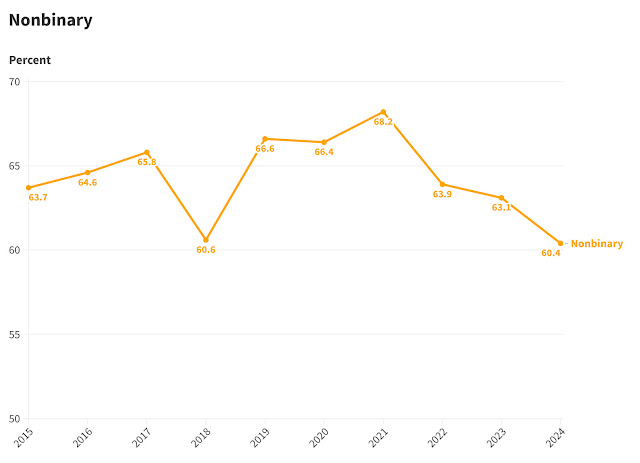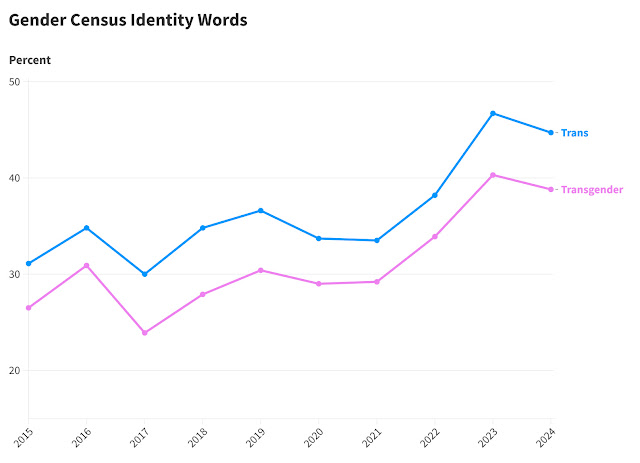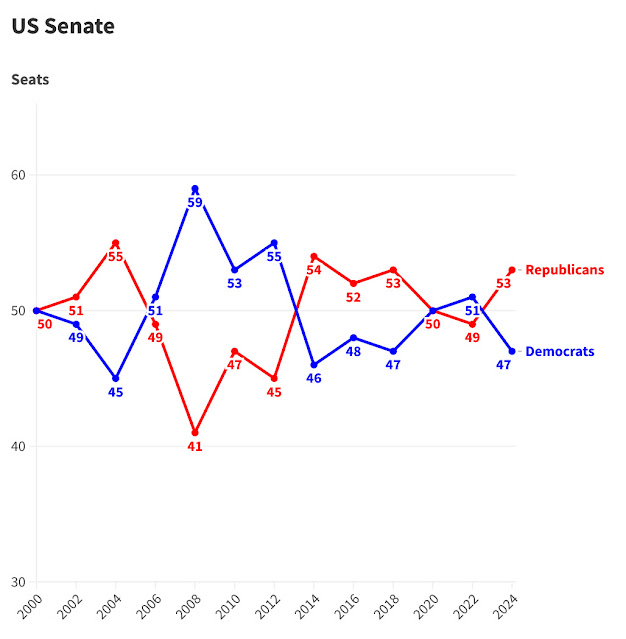For the past 10 years, the Gender Census has collected useful information about nonbinary people.
Across a decade, the results of the Gender Census have been remarkably consistent.
All 11 identity terms chosen by at least 20 percent of respondents, at any point since 2015, remain above 20 percent today.
Therefore, if you learn the most common nonbinary identities, that knowledge will continue to be relevant in subsequent years.
Once you
know the most common terms, you won’t
have to regularly learn an entirely new lexicon to stay up to date.
The Gender Census is an annual global online survey of people who have a gender that isn’t strictly male or female.
This article is part of Season 3 of LGBT by the Numbers, a series that examines statistics about LGBT people in the US, and around the world.
I wrote an article introducing Season 3, and explored the results of the 2024 Gender Census.
The first Gender Census was conducted in 2013, and the second Gender Census was conducted in 2015.
Based on the results of these surveys, the most common term used by people with a gender outside the binary appears to have changed from genderqueer to nonbinary around 2014.
I examined this result in the most recent article in the series.
The 2013 Gender Census had fewer respondents than any subsequent survey, and Cassian, the administrator of the Gender Census, has described the 2013 survey as, “more of a pilot survey that informed a better survey in 2015.”
This article, and the ones that follow, will focus on the results from 2015 to the present, although data from 2013 will be referenced when relevant.
We will explore how the terms included in the 2024 Gender Census have performed over the past 10 years.
In this article, we’ll begin by examining the most popular terms from the 2024 Gender Census.
This graph shows how the seven most popular identity terms from 2024 have performed in each Gender Census since 2015.
We’ll explore the top five terms today.
Make sure to pay attention to the Y-axes of the line graphs in this series. Very few of them will begin at 0.
I created the graphs in this article using flourish, a website that allows users to create compelling visual aids.
Nonbinary
Nonbinary refers to someone whose gender identity isn’t exclusively male or female.
Every year since 2015, nonbinary has been the identity term chosen by the most Gender Census respondents.
You may find yourself in a situation where you want to refer to the group of people who don’t identify as male or female.
Nonbinary is the best word you can use in this situation, based on the results of the Gender Census.
For example, you might want to ask someone their gender, either in person, or as a question on an official document.
When addressing a group of people, you might want to use gendered language, without leaving anyone out, such as, “men, women, and nonbinary people,” or “ladies, gentlemen, and nonbinary guests.”
Since 2015, nonbinary’s performance in the Gender Census has been strong and consistent, although it has slowly and narrowly declined in recent years.
Nonbinary’s maximum was 68.2% in 2021.
Nonbinary’s minimum was 60.4% in 2024.
Therefore, nonbinary’s range is 7.8%.
That’s a small range compared to the other top terms in the Gender Census.
The ranges listed in this series refer to the past 10 years, from 2015-24, which means they don't include the results of the pilot 2013 survey.
Nonbinary is the only term that has ever surpassed 60% in the Gender Census.
In 2013, nonbinary received 38.6%, which is considerably less than it has received in subsequent years.
I discussed nonbinary’s performance in the 2013 Gender Census in an earlier article.
Queer
Queer is an umbrella term that refers to anyone who is LGBT, including nonbinary people.
I discussed the meaning and history of the term “queer” in The Big Picture and Thoughts on the Acronym, which are both part of Season 1 of LGBT by the Numbers.
Queer can be used to describe someone’s sexuality or gender.
When it first appeared as a checkbox in 2019, queer was the second most commonly chosen term.
In subsequent surveys, Cassian added a parenthetical to queer to clarify they are asking respondents whether they describe their gender as queer.
In ‘20 and ’21 the checkbox was, “queer (partially or completely in relation to gender)”.
In ’22, ’23, and ‘24 the checkbox was, “queer (in relation to gender)”.
Other than nonbinary, Queer is the only other term that has been chosen by a majority of Gender Census respondents, since 2015.
Queer received more than 50% in ’22, ’23, and ’24.
Queer has been the second most popular term in the Gender Census, since it first appeared as a checkbox option in 2019.
Queer’s minimum was 42.9% in 2020.
Queer’s maximum was 54.8% in 2023.
Therefore, queer’s range is 11.9%.
Trans & Transgender
Transgender describes someone who identifies with a gender different than the one they were assigned at birth.
Trans is a shortened form of transgender.
In the 2024 Gender Census, trans was the third most popular term, and transgender was the fifth most popular term.
Trans and transgender rise and fall in synchronicity in the Gender Census.
Trans is consistently chosen by a larger number of respondents.
On average, trans outperforms transgender by 5.3%.
Trans
Trans has been the third most popular term in the Gender Census since 2022.
As you can see, the popularity of trans has increased in recent years.
In 2017, trans reached its minimum of 30.0%.
In 2023, trans reached its maximum of 46.7%.
Therefore, trans has a range of 16.7%.
Trans has the second largest range of any identity term in the Gender Census.
Transgender
Transgender has been the fifth most popular term in the Gender Census since 2022.
Transgender has also seen an increase in popularity in recent years.
First, let’s look at transgender’s performance in the Gender Census since 2015.
Transgender’s minimum was 23.9% in 2017.
Transgender’s maximum was 40.3% in 2023.
Therefore, transgender has a range of 16.4%.
Transgender has the third largest range of any identity term in the Gender Census.
In 2013, transgender was chosen by 23.7% of respondents, which is less than it has received in any subsequent survey.
We have discussed the first, second, third, and fifth most popular terms from the 2024 Gender Census.
But, we still need to discuss the fourth most popular checkbox identity, “A person / human / [my name] / ‘I’m just me.’ "
However, to understand this option, we must first examine the history of one of the least popular options on the Gender Census, “none.”
None
The Gender Census asks respondents, “Which of the following best describe(s) in English how you think of yourself?”
Respondents can choose as many checkbox terms as they wish, and they can also submit write-in responses.
One of the
checkbox options is, “none.”
"None" was the third least commonly selected checkbox in 2024.
"None" was only chosen by 4.6% of respondents.
A small change in the wording of the option for “none” in 2022 had a large effect on the number of people who chose it.
“None” was first introduced as an option in 2016, and its wording has undergone a few subtle changes over time.
In 2016, it was, “none / do not describe.”
In 2017, it was, “none / I do not describe.”
From 2018-21, it was, “none / I do not describe myself.”
In 2022, Cassian, who administers the Gender Census, changed the option for “none” to “ none / I do not describe myself / ‘I’m just me.’ ”
Cassian did so because respondents submitted write-ins that were similar to what Cassian meant to convey through the option for “none.”
Examples of these write-ins included terms like, "person, human, [my name], and 'I’m just me.' "
The addition of “I’m just me,” spiked the popularity of "none" from 4.4% in 2021 to 16.9% in 2022.
Cassian changed the wording back to, “none / I do not describe myself,” for 2023 and 2024.
But the popularity of the “I’m just me” addendum in 2022 convinced Cassian to add a different option to the Gender Census, beginning in 2023.
A person / human / [my name] / “I’m just me”
Based on feedback, Cassian added the option listed above as a checkbox in 2023.
In their report on that year’s results, Cassian described the checkbox as, “an affirmative description," based on write-ins, as opposed to, “a lack of description,” for the “none” option.
“A person …” received 42.5% in 2023.
“A person …” received 39.1% in 2024.
In both years, “A person …” was the fourth most popular checkbox option.
That’s a pretty strong performance, especially for a somewhat inscrutable choice.
"A person..." appears in yellow on the line graph below.
At first glance, it might not seem fair for compact terms, often consisting of only a single word, to compete with such a long-winded response.
The amalgamate consists of four separate responses, divided by slashes.
However, I do believe the composite does represent a single idea.
These are all responses where someone seeks to avoid characterizing their gender, and instead describes themselves based on a non-gendered descriptor.
I personally find it strange to dodge the question of how you describe your gender, in a survey about that very topic, but it’s an approach that is widely shared by nonbinary people, as the results from the last two years can attest.
I believe it makes sense to continue to include the verbose response among the checkbox options in future surveys, despite its inherent clunkiness.
If you would like to learn more, I discussed the terms nonbinary, queer, trans, and transgender in an article I wrote about the results of the 2023 Gender Census.
In the next article, we’ll continue our tour of Gender Census results by examining gender non-conforming, genderqueer, and enby.










@2x.jpeg)

@2x.jpeg)












